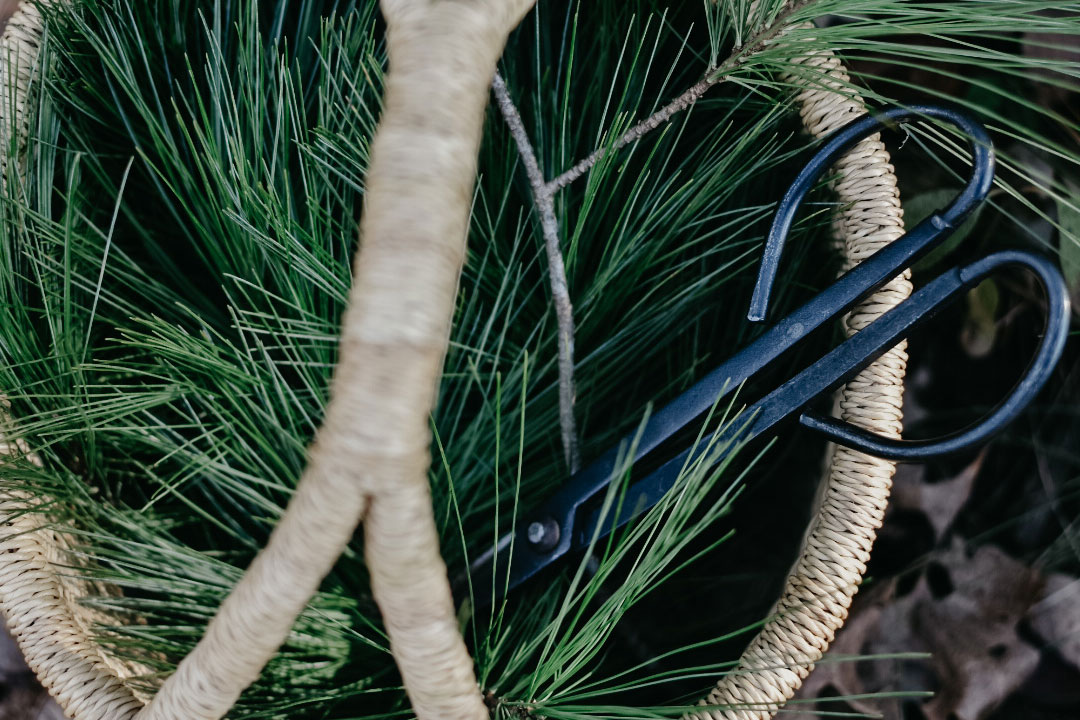
Your Guide to Winter Foraging
Something magical happens in the winter. Our pace slows, the world grows quiet, and we cozy up in our homes with a more inward focus. We’re inviting you out into the quiet world and beckoning you away from your snug nest to go with us on a winter foraging journey. Despite the drop in temperatures, and maybe even a little snow on the ground, winter foraging isn’t just possible; it’s positively joyful!
Before you wrap up in your thickest scarf and grab your foraging bag, an important reminder: less green naturally means less plant material for animals. The sustainability rules for other seasons apply just as much, if not more, to winter foraging, and we encourage you to leave as much as you can for our wild friends! It’s also just as important to have a firm grasp on what you’re harvesting—only harvest when you can confidently identify or have someone with you who can! Finally, always forage far from roadsides or areas that have used chemical treatments. Find more wildcrafting and foraging tips here!
We recommend you use this guide as an outline for your own research. It’s important to research uses and safety information on your own prior to harvesting any of the below plants (or any plants, for that matter!). It’s important to understand the plant—and your body—before taking anything new, and always check with your practitioner if you have any questions before introducing a new herb to your diet or routine. For access to plant monographs, plant use information, and guidelines, The Herbarium is a wonderful resource.
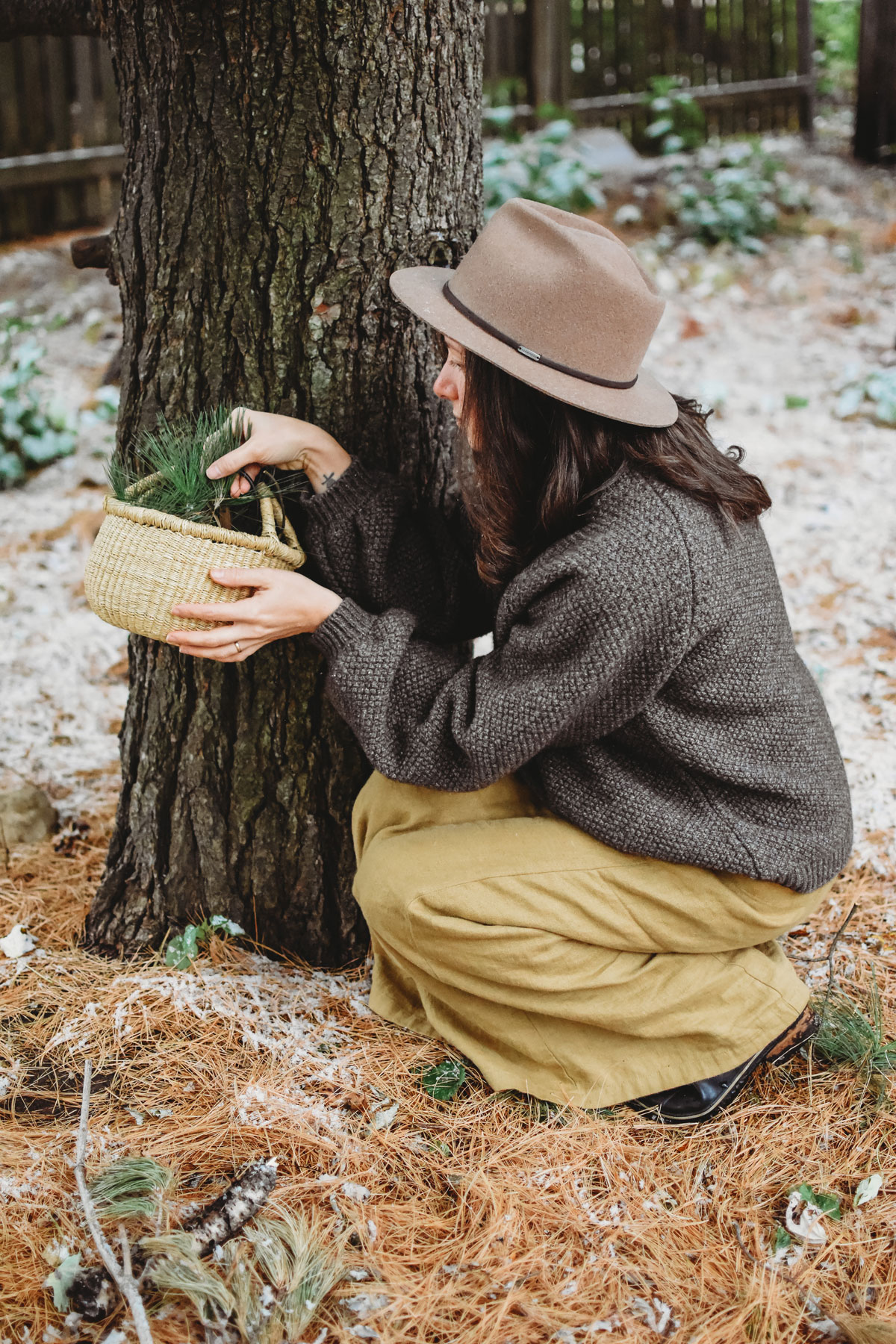
Trees
Evergreens remain thriving and abundant, even in the winter, making them the perfect first stop on a winter foraging journey. Easy to identify and available in nearly every climate, trees are a great place to start if you’re new to foraging as well. Harvest from more mature trees and avoid harvesting from the top, which could stunt the tree’s growth.
Conifer Needles
Most conifer needles are edible, with the exception of the toxic yew (Taxus spp.) tree. Spruce, hemlock (the evergreen, not the plant), pine, fir, and redwood all have wonderful herbal and edible uses. Conifer needles are especially useful in teas but have been used in applications varying from salves to body scrubs to infusions.
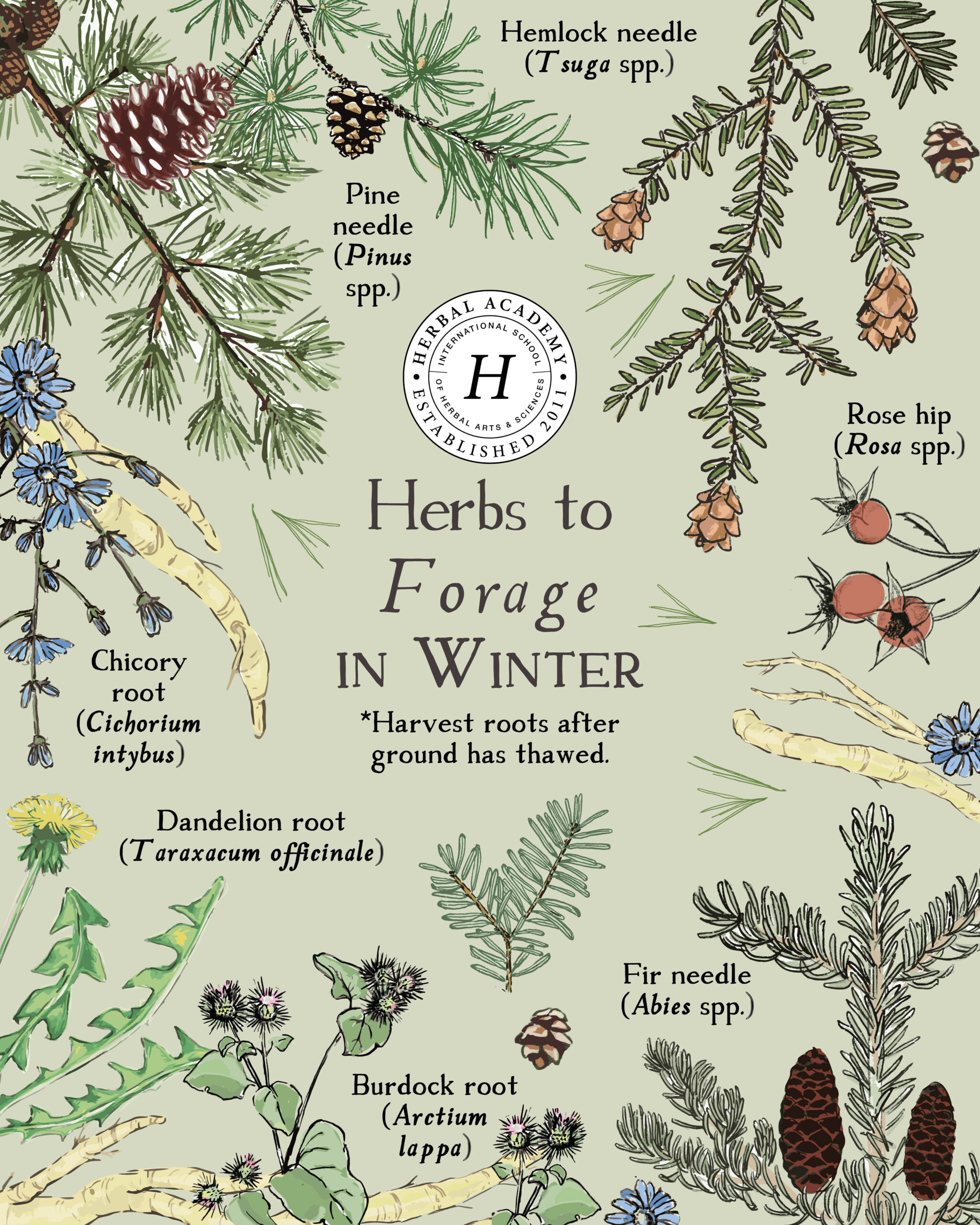
Fir (Abies spp.)
How to ID: The needles of a fir tree are soft and flat and grow from a single point of origin, much like spruce. Where a fir needle’s growth differs from spruce is that it’s attached to the branch in a way that resembles a suction cup. Fir needles tend to have two white stripes on the bottom of each needle.
Uses and Properties: Douglas fir has a long history of being employed by indigenous North Americans for various complaints. The fir resin’s antiseptic properties are used in poultices for cuts, burns, and other skin ailments (Kress, 2012). The young shoot tips, which offer analgesic, expectorant, and stimulant properties (Haines, 2010 & 2015; Moore, 2004), can also be used as a flavoring in cooking. The more tender needles work marvelously in a woodsy tea.
Hemlock (Tsuga spp.)
How to ID: The needles of a hemlock tree are soft and flat and are attached individually to the branch, not in bunches like pine trees. Hemlock needles, like fir needles, have two white stripes on the underside. Hemlock trees are dark green and have somewhat droopy lacy-looking branches.
Uses and Properties: Small branches or twigs with many needles can be used to brew a kidney-supportive tea. The steam produced from hemlock needle tea can also be used to support those with rheumatism, colds, or coughs. (Moore, 2003)
Pine (Pinus spp.)
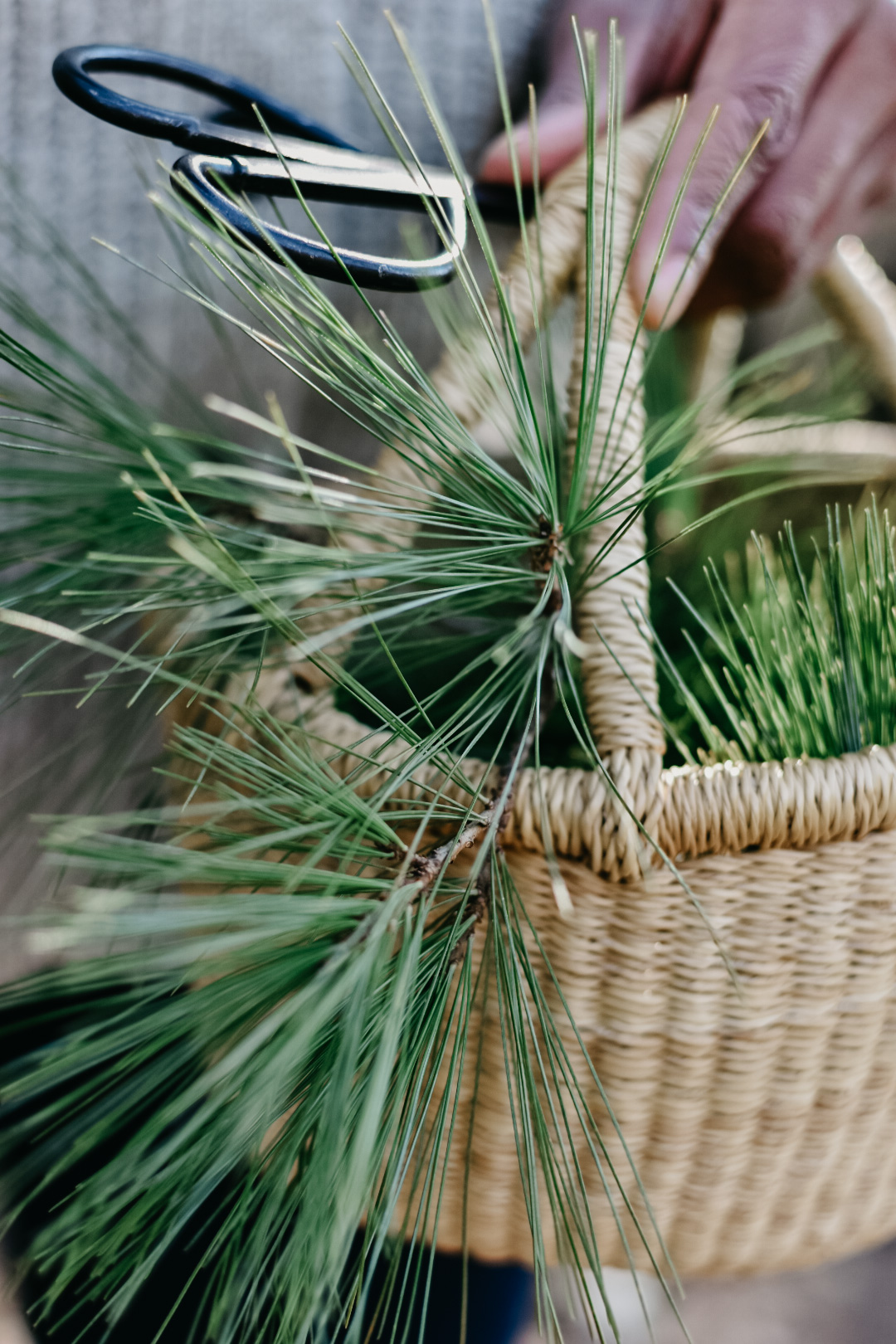
How to ID: Pines are most recognizable by seed-producing cones, needles arranged in sharp-tipped bundles called fascicles, and rings of branches (botanically termed whorls) that the tree produces from the top level (Earle, 2020). You may also identify a pine tree by noting how its cones hang down, whereas other cone-producing conifers (like a fir tree) tend to have cones that grow upward from the branches.
Uses and Properties: Pine needles are high in vitamin C and have been used in the past to keep scurvy away (Deane, n.d.). One of the fastest ways to utilize the pine needles’ vitamin content is by brewing a cold-infused pine needle tea made from fresh, crushed pine needles. (Vitamin C is heat-sensitive, so the cold water retains the vitamin content better than hot water.) Pine needles also ease pain and have anti-inflammatory properties, and they are also antiseptic, antibacterial, and antifungal, which makes them ideal for salves. (Walker, 2015).
Redwood (Sequoia sempervirens)
How to ID: Redwood needles are shaped like a double-edged sword and occur in a flat plane. They are typically about ½-1-inch long and are green on top with distinct white bands below. They’ll release their oils immediately when handled, so harvest delicately.
Uses and Properties: Similar to all other conifer needles, redwood needles are high in vitamin C (Haines, 2010 & 2015; Moore, 2004). They’re also antimicrobial and can help stimulate circulation (Moerman, 1998). A delicious, vitamin-rich tea may be cold-brewed from redwood needles, or buttery, rich shortbread cookies can be made by chopping up fresh needles and adding them to shortbread dough.
Spruce (Picea spp.)
How to ID: Spruce needles have four sides to them and are individually attached to the branch. Another way to identify spruce trees is by their cones that are covered with smooth thin scales. The cones tend to be quite flexible.
Uses and Properties: High in vitamin C, spruce needles make a tasty, lemony tea that is helpful for colds. The needles may also be used for an aromatic steam to help alleviate congestion. Spruce salve is helpful, particularly for skin chafing and windburn (Moerman, 1998).
Recipes and Tips:
To start crafting with conifers, check out the recipes in:
3 Conifer Cordial Recipes for Winter Wellness
8 Terrific Ways to Use Pine Needles Right Now
Conifer Gin & Bubbles: A Holiday Cocktail (Video)
Woodland Winter: Stovetop Potpourri Blend
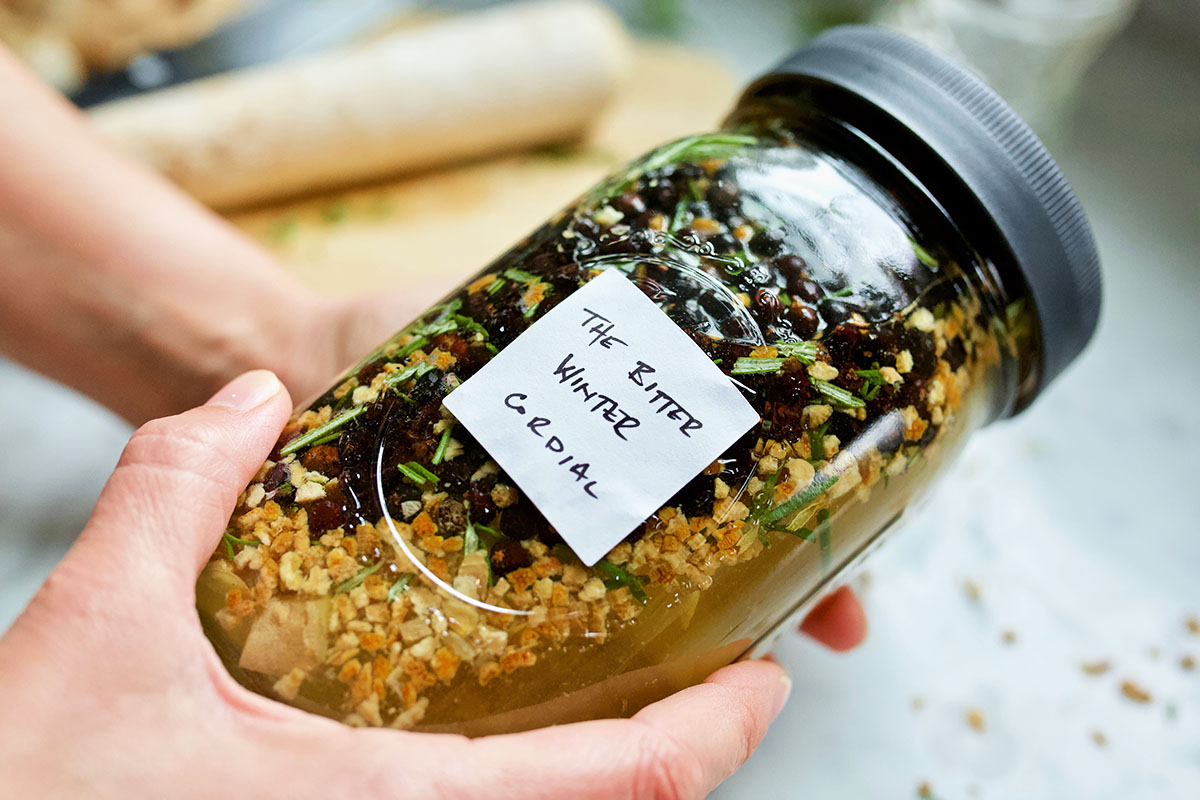
Juniper Berries
How to ID: You’ll know juniper (Juniperus spp.) berries immediately by seeing the rich blue berries popping against the deep green of the juniper tree. An even more fun fact? Juniper berries aren’t actually berries at all; they are small, fleshy cones! When harvesting, collect the ripe berries, which are blue to silvery-purple in color and may be covered in a bloom, which will fade during the drying process.
Uses and Properties: Juniper is often used to flavor gin, but that only scratches the surface of its uses! As an antimicrobial, juniper is useful for upper respiratory and gastrointestinal tract infections (Buhner, 2012) and is well known among herbalists as an effective agent against vaginal and urinary tract infections (Moore, 1989).
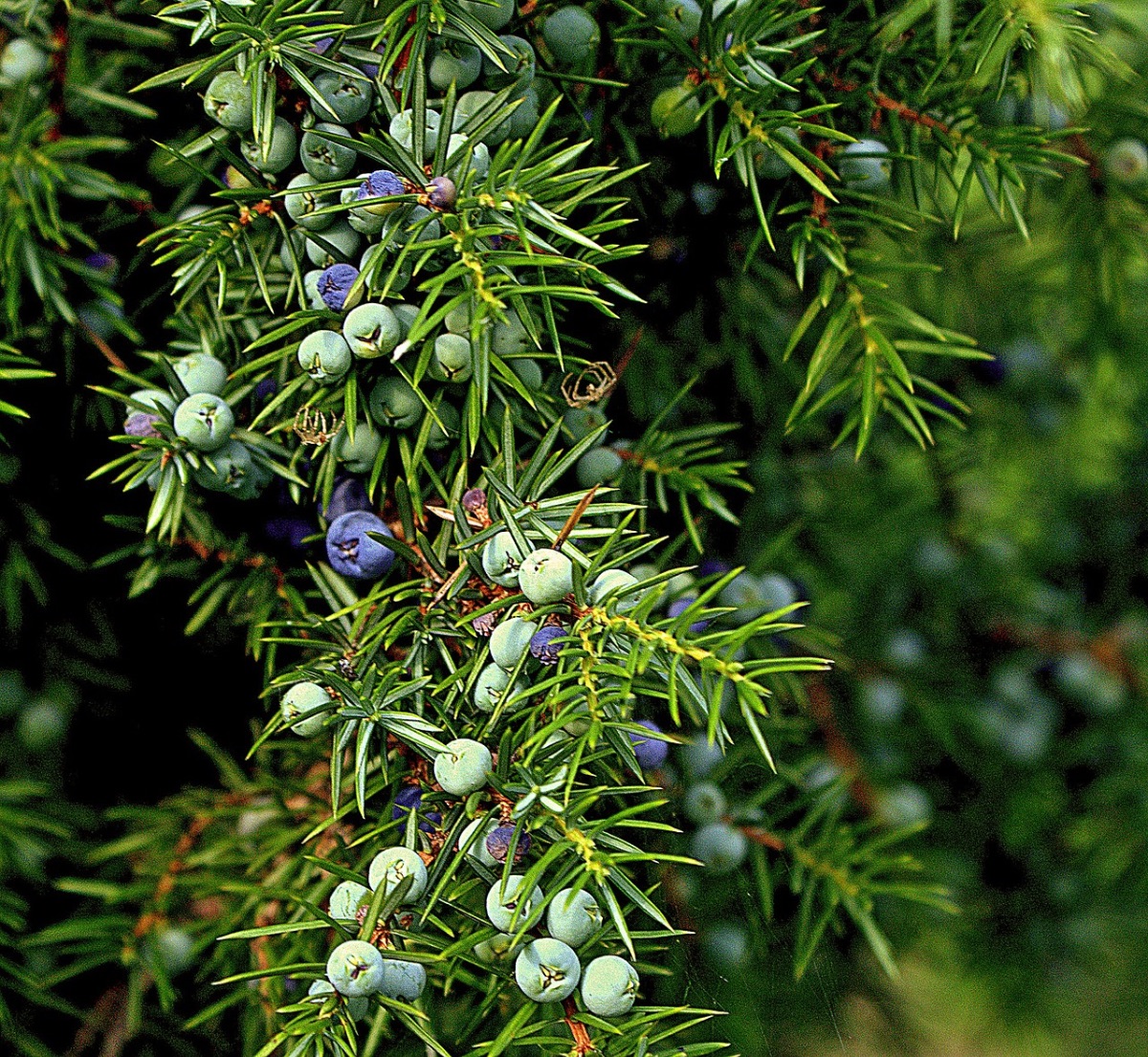
Recipes and Tips:
Kapha Massage Oil
Comfrey Cream for Muscle and Joint Comfort (features juniper berry essential oil)
Aromatic Fire Starter
Nuts and Seeds
You’ll need a keen eye when hunting for nuts and seeds while you’re on your winter foraging walk. Nuts and seeds are easier to spot in the fall but, by winter, animals will have had their fill! There may still be some hanging on, ready for you to uncover their uses.
Acorns
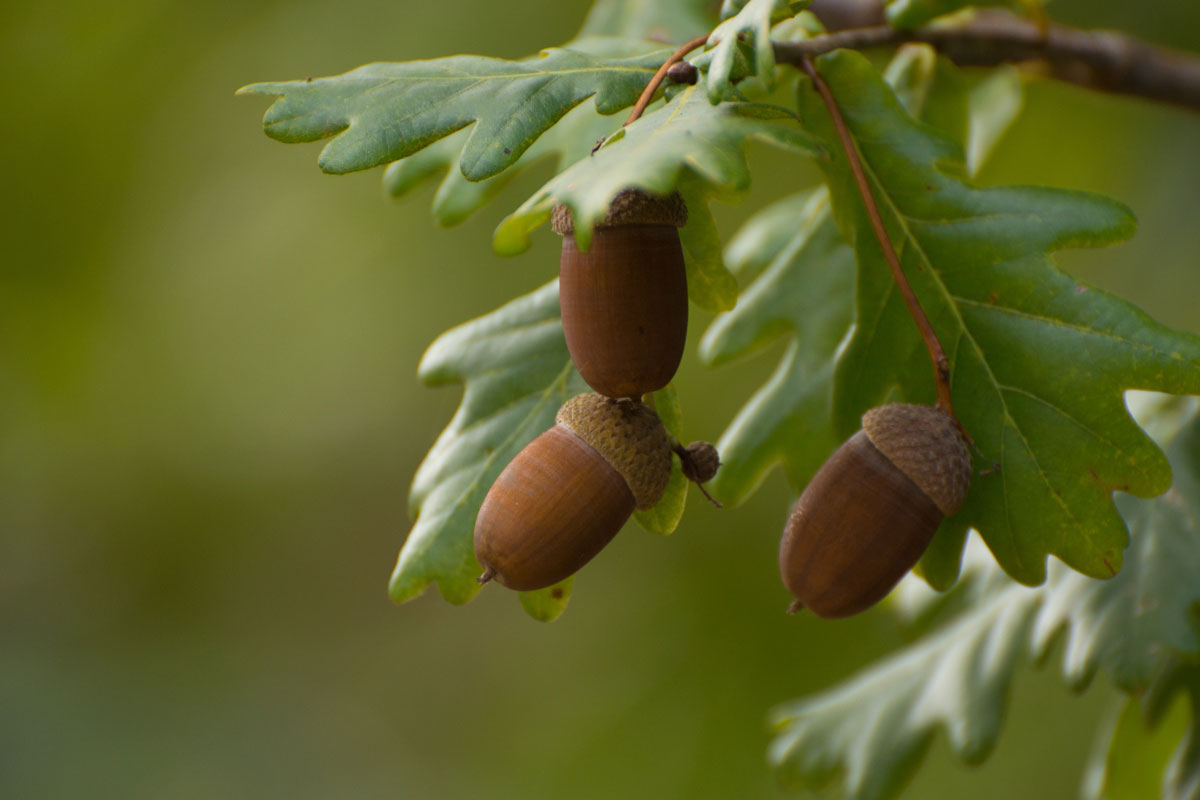
How to ID: The nut of the acorn grows from a woody cup, which may remind you of a little hat. All oaks native to North America and Europe have a spiral of overlapping scales on the cup. While you won’t be able to immediately use an acorn after its harvest, the patience is well worth it! To test the viability of acorns once you’re back at home, place your haul in a bowl of water. If any float, discard them.
Uses and Properties: While acorns don’t have herbal uses, they have countless edible purposes! Ground acorns can be used as a flour substitute for bread, pancakes, pastries, cookies, and even pasta. Because acorn flour is much hardier than regular, all-purpose flour, you may want to use it in just a portion of the recipe and/or slightly adjust your cooking times.
Recipes and Tips:
How to Make Acorn Flour
Acorn Cake
Acorn Porridge
Dock Seeds (Rumex crispus)
How to ID: Yellow dock is a wonderful plant that offers gifts throughout the seasons. Come winter, the plants will die back, leaving the dried seeds for harvest. The seeds of yellow dock form in little seed pods, which persist even in the winter. The pods are smooth, with winged edges.
If you live in a warmer climate, you may be able to harvest the root in the winter as well!
Uses and Properties: The seeds can be ground for a flour replacement, can be eaten raw or cooked, and can also be used as a coffee substitute.
Recipes and Tips:
How to Make Dock Seed Flour
Dock Seed Crackers
Berries
The texture of berries changes slightly in the winter, especially after heavy frost or snow. But they’ll still be perfectly usable for jams, jellies, or syrups.
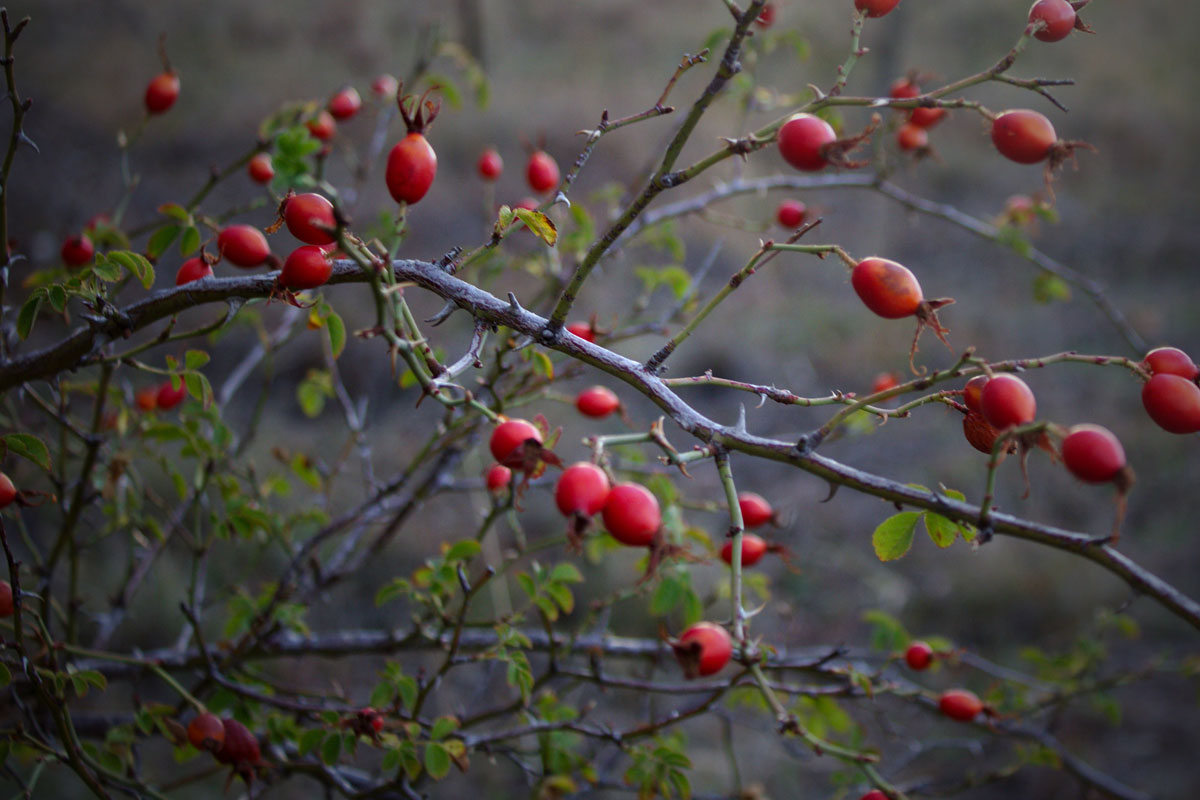
Rose (Rosa spp.) hips
How to ID: Rose hips are the fruit of roses, replacing the freshly fallen flowers when the temperature begins to grow colder. Rose hips typically fruit in the fall, but may hang on throughout the winter in some areas. They are red to orange in color, oblong or round in shape, often with small wisps of “hair” protruding from the bottom.
Uses and Properties: Rose hips are very high in vitamin C, with nearly 200% of the recommended daily value in just 1 ounce of fresh, wild rose hips (Nutrition Data, n.d.a). Dried rose hips contain about 68% of the daily value for vitamin C and 63% of the daily value of vitamin A; they are also a good source of folate, potassium, calcium, and magnesium (Nutrition Data, n.d.b). It has been surmised that the health benefits of rose hips are primarily due to their high vitamin C content.
Recipes and Tips:
Firming Wild Rose Under Eye Cream
Rose Hip Jam
Hawthorn (Crataegus spp.) berry
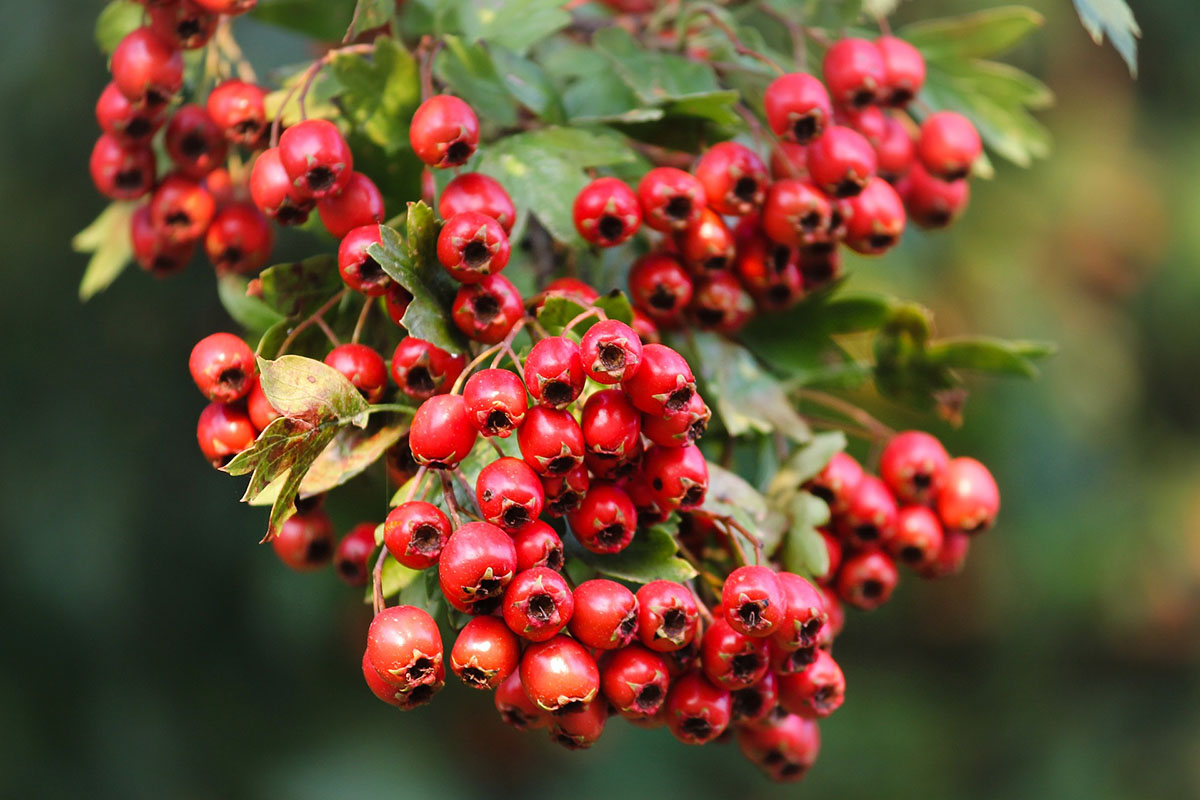
How to ID: Hawthorn grows as a small tree or shrub, which produces clusters of white flowers in the spring. The berries ripen in early to late autumn, depending on your location and tree species. Once they are fully ripe, pick them from the branches, carefully avoiding the sharp spines.
Uses and Properties:
Hawthorn berries are high in pectin, so they make great jams (just remove the seeds!). Herbalists use hawthorn extract (from berry, leaf, and/or flower) as a general cardiac tonic, a cardiac trophorestorative, and for cases of angina, high blood pressure, early stages of congestive heart failure, and atherosclerosis (Murray, 1995). It is the go-to herb for any heart-related condition, including helping to support the heart following a heart attack. The flavonoids (proanthocyanidins and anthocyanidins) in hawthorn extract are thought to promote these actions, but according to Verma et al. (2007), no conclusive cause or single source to those effects have been found. Hawthorn berries, leaves, and flowers are also used as nervines and anti-inflammatory herbs.
Recipes and Tips:
Hawthorn Berry Homemade Cordial
Overnight Hawthorn Infusion

Wintergreen (Gaultheria procumbens)
How to ID: Wintergreen is a low plant, growing from slender, creeping underground stems that form small colonies of plants. The branches arising from these stems are upright, about two to six inches high. The leaves of wintergreen have a strong minty fragrance and are arranged alternately, meaning that they emerge from the stem one per node.
In the winter, the plant berries remain and can be harvested and eaten a few at a time or used in tea. It’s important to note that wintergreen is listed as endangered in Illinois, so please harvest infrequently.
Uses and Properties: Wintergreen leaf can be used to make a beverage tea. The salicylate content in wintergreen preparations lends it analgesic action, noted by North American indigenous tribes including the Algonquin people (Native American Ethnobotany Database, 2003) and Eclectic practitioners of the late 18th and early 19th centuries (Felter & Lloyd, 1898), as well as use for digestive issues and respiratory support.
Due to potential salicylate toxicity, care should be taken; there is no data on the exact methyl salicylate content in wintergreen tea. However, we do know that there is a very low amount of salicylate in the fresh leaf; a 30-minute infusion is unlikely to produce full enzymatic conversion of the salicylate compounds, and wintergreen tea has a long history of safe use. Wintergreen herb has an assigned safety rating of 1A, indicating that it is generally safe when used appropriately (McGuffin & Gardner, 2013).
Recipes and Tips:
The Trick for Delicious Wintergreen Tea
Wintergreen Extract
Roots
Roots are a common and ideal target for winter foraging because, as long as the root is viable, it is completely okay if the bits above ground have fallen away. If the ground is frozen, you’ll make for hard work for yourself, so aim to go before a deep snow or a long stretch of cold temperatures.
Burdock (Arctium lappa)
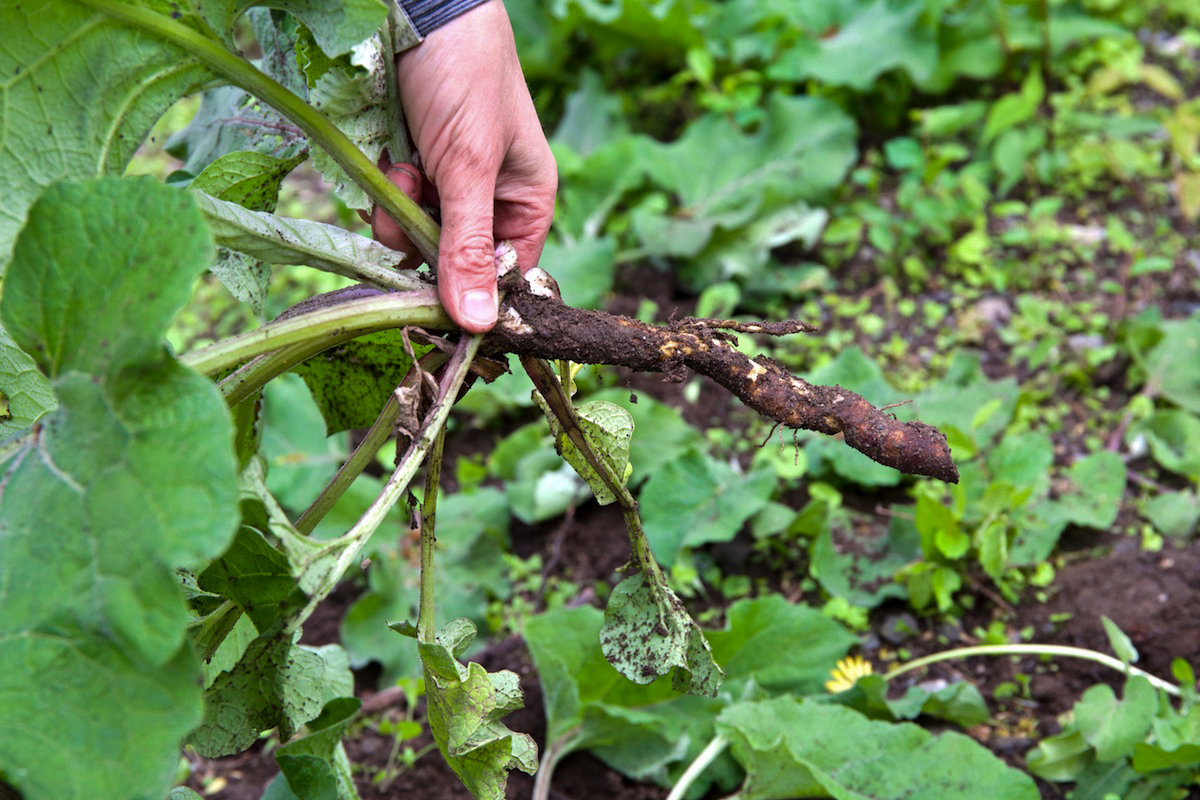
How to ID: Burdock is biennial, which means it’s most ideal to harvest in the first year, when all of its energy and vitamins are brought to the roots for the winter. It’s best to identify a burdock plant in the summer and fall, before much of the plant dies back. However, if you notice thistle-like brown burrs on the ground or sticking to your shoes, there is a good chance burdock is nearby! Burdock roots can grow to 2 to 3 feet in length.
Uses and Properties: Burdock is used for improving digestion because the root contains inulin, a prebiotic that feeds the gut microbiome. As a mild bitter, burdock also tonifies the digestive system by stimulating the secretion of bile. This helps improve appetite and digestion, thereby supporting the health of the whole body. Burdock root is also hypoglycemic, mildly lymphatic (improves the flow of lymph through the body), and anti-inflammatory (Hoffmann, 2010).
Recipes and Tips:
Pickled Burdock Root
Root Tonic for the Liver
Chicory (Cichorium intybus)
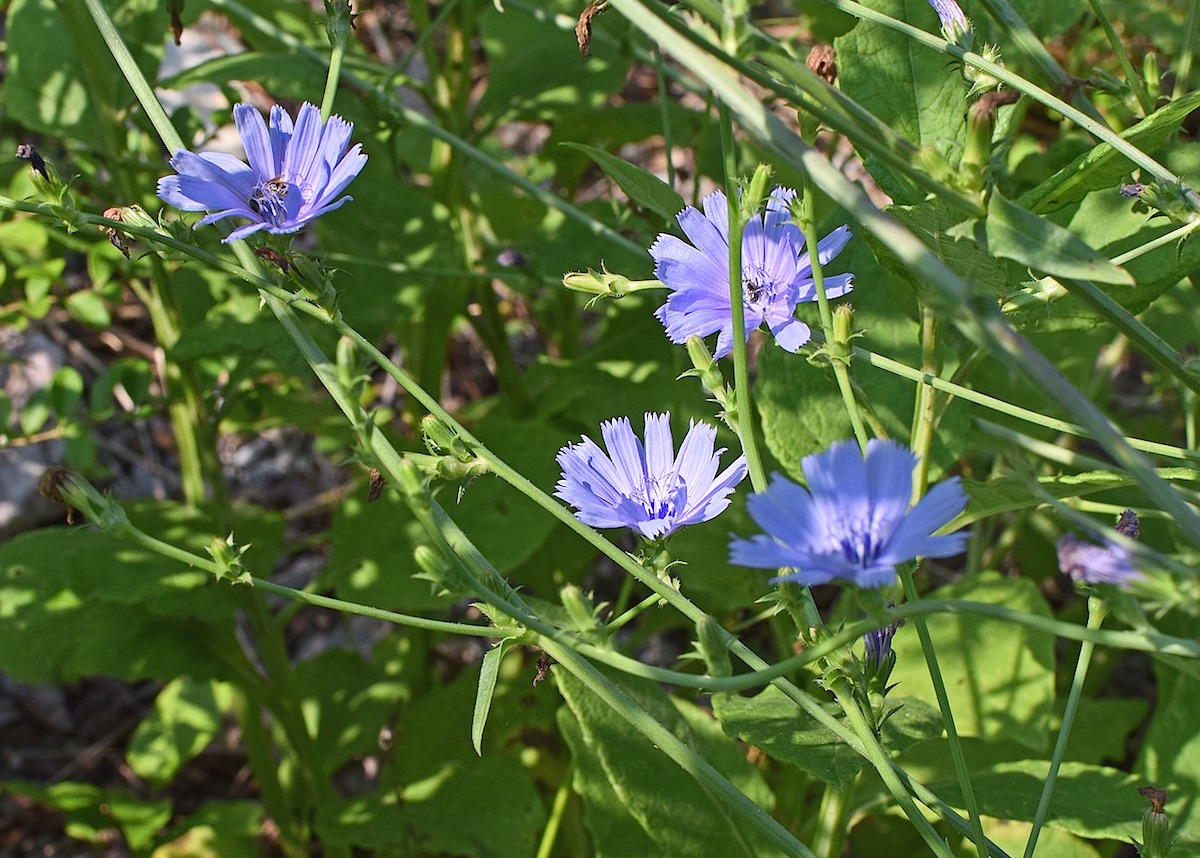
How to ID: Similar to burdock (as with most roots), it’s best to identify chicory in the summer when their vibrant blue flowers are popping up across landscapes. Chicory is a branching, scraggly-looking plant. It often stands out alone in gravel areas, or open weedy fields and the flowers only open on a sunny day. The flowers are 2 to 4 cm wide and are usually a bright, light blue. There are two rows of involucral bracts—the inner are longer and erect, the outer are shorter and spreading. Chicory flowers from July until October.
Uses and Properties:
Chicory root is most commonly known for its use as a coffee replacement (and a delicious one at that). Before using, however, be sure to clean the root of all dirt and roast them in the oven to develop the lovely coffee-like flavor!
Recipes and Tips:
Homemade Dandelion and Chicory Root Coffee
Dandelion (Taraxacum officinale)
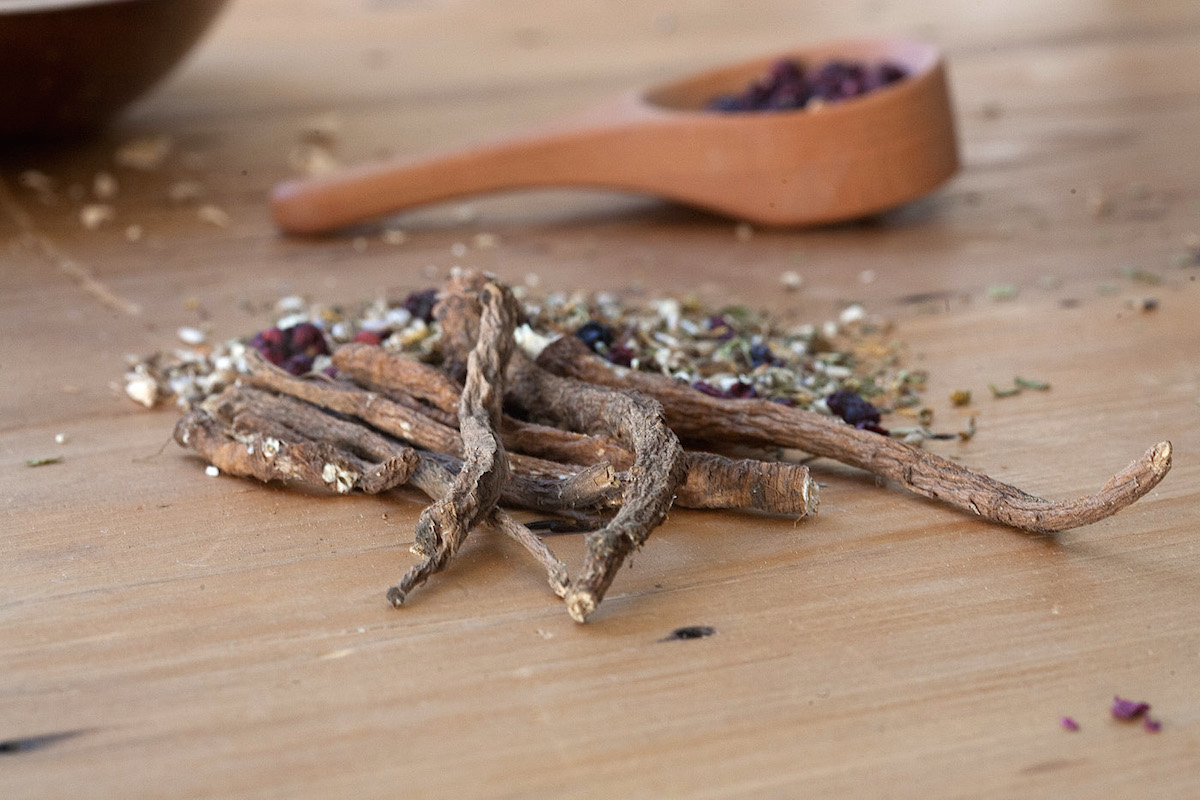
How to ID: Dandelion root can still be harvested in the winter! And, if you’re having a particularly warm winter, don’t be surprised if you see dandelion’s bright yellow flowers popping up in your yard. Dandelion leaves are hairless and generally have toothed edges. The leaves and hollow flower stems grow directly from the rootstock.
Uses and Properties: Dandelion roots are a great mild bitter to support healthy digestion and improve appetite, and can be enjoyed as a decoction or included in soups and stir-fries. With an inulin content up to 25% (Tillotson, 2001) and even to 40% (Foster, 1993), late harvest dandelion root is excellent nourishment for the body’s beneficial microorganisms in the gut. Avoid dandelion in individuals with gallstones (McGuffin & Gardner, 2013).
Recipes and Tips:
Dandelion Root, Gentian, and Licorice Root Bitters Recipe
Dandelion Root, Motherwort, and Lemon Tonic Tea recipe
Preparing for Winter Foraging
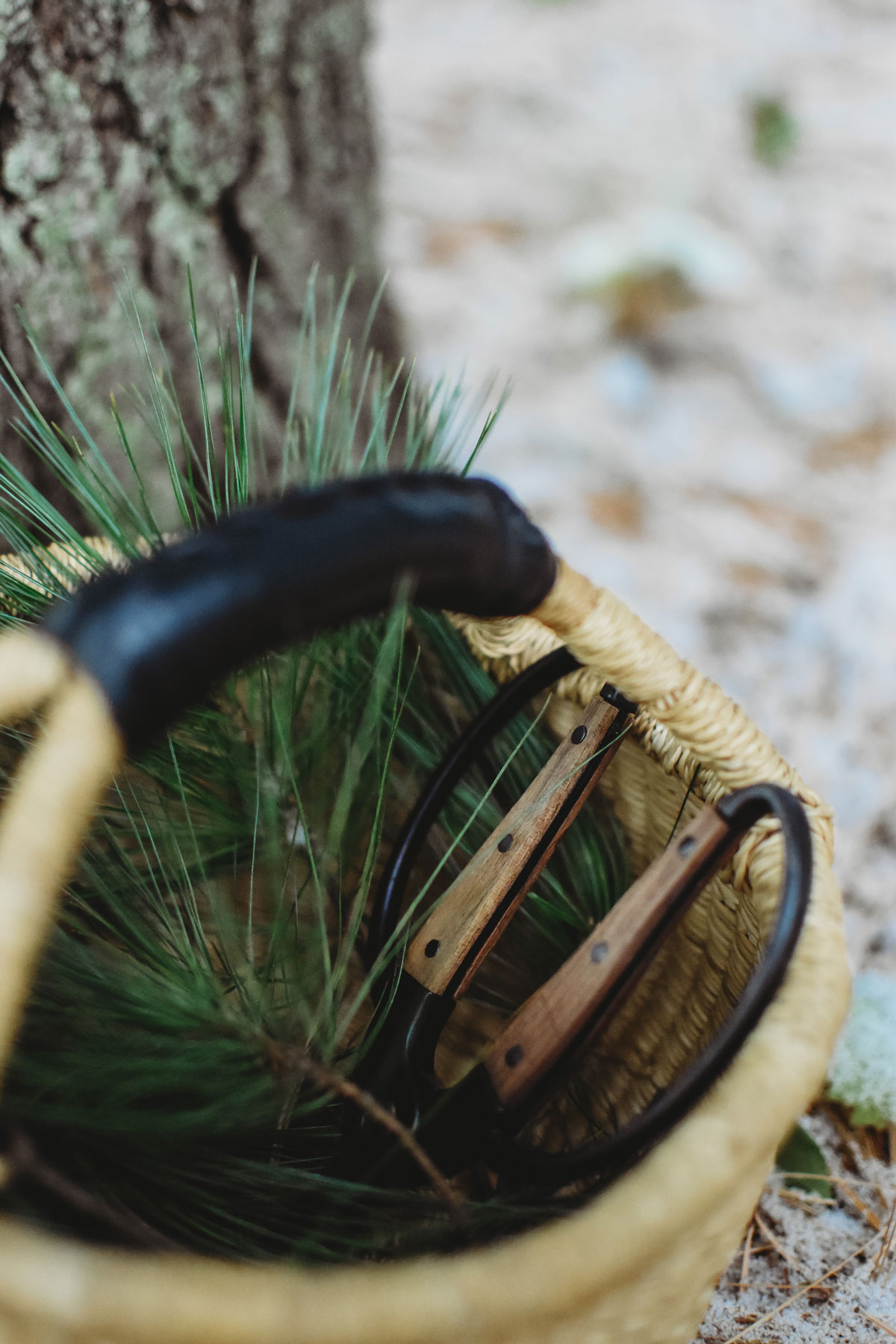
As with any time of year, it’s important to only forage from areas that you’re familiar with, have permission to harvest from, and are confident are not impacted by herbicides, pesticides, road runoff, or petrochemicals. In a particularly unique season where we are in our homes more than normal, a winter foraging excursion may be just what you need to connect with the plants and inspire your studies while getting fresh air and exercise. Harvest safely, harvest sustainably, and only harvest plants that you’re completely certain you have identified correctly. Above all, enjoy being in nature and connecting with plants in a unique and important way!
We have created some comprehensive and incredibly useful courses to guide you in your foraging adventures, as well. For a more in-depth look at the plants mentioned above (and so many more!), enroll in The Foraging Course or the Botany & Wildcrafting Course. These courses are specially designed for those looking to deepen their understanding of the countless useful plants around them and test their plant knowledge in the wild!
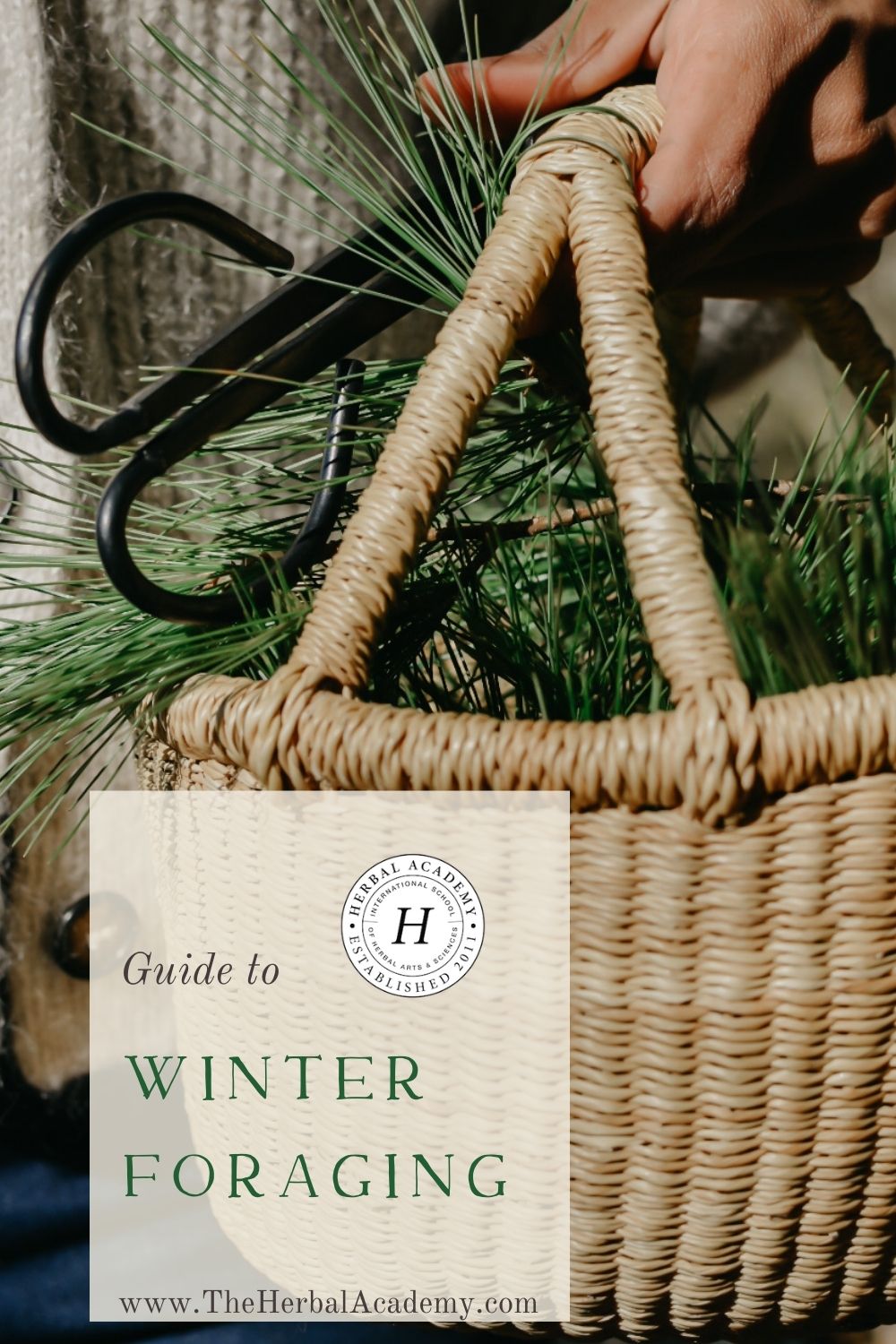
REFERENCES
Buhner, S. (2012). Herbal antibiotics: Natural alternatives for treating drug-resistant bacteria. North Adams, MA: Storey Publishing.
Deane, G. (n.d.). Pining for You [Blog Post.] Retrieved from http://www.eattheweeds.com/pines-not-just-for-breakfast-anymore-2/
Earle, C.J. (2020). Pinus (pine). The gymnosperm database. Retrieved from https://www.conifers.org/pi/Pinus.php
Foster, Steven. (1993). Herbal renaissance. Layton, UT: Peregrine Smith Books.
Haines, A. (2010). Ancestral Plants, Volume 1. Turner, ME: Anaskimin.
Haines, A. (2015). Ancestral Plants, Volume 2. Turner, ME: Anaskimin.
Hoffmann, David. (2003). Medical herbalism. Rochester, VT: Healing Arts Press
Kress, H. (2012). Fir, spruce pine. Retrieved from http://www.henriettes-herb.com/blog/hotw-fir-spruce-pine.html
McGuffin, M., & Gardner, Z. (Eds.). (2013). American Herbal Products Association’s botanical safety handbook. (2nd ed.) Boca Raton, FL: CRC Press.
Moore, M. (1989). Medicinal plants of the desert and canyon West. Santa Fe, NM: Museum of New Mexico Press.
Moore, M. (2003). Medicinal plants of the mountain west. Santa Fe, NM: Museum of New Mexico Press.
Moore, M. (2004). Southwest School of Botanical Medicine, author’s class notes.
Moerman. D (1998). Native American ethnobotany. Timber Press. Oregon.
Murray, Michael T. (1995). The healing power of herbs. Rocklin, CA: Prima Publishing.
Native American Ethnobotany Database. (2003). Gaultheria procumbens [Online database]. Retrieved from http://naeb.brit.org/uses/search/?string=Gaultheria+procumbens
Nutrition Data. (n.d.b). Rose hip dried [Online Database]. Retrieved from https://nutritiondata.self.com/facts/custom/2340250/2?quantity=0.15
Nutrition Data. (n.d.a). Rose hips, wild [Online Database]. Retrieved from https://nutritiondata.self.com/facts/ethnic-foods/10470/2
Verma, S.K., Jain, V., Verma, D., & Khamesra, R. (2007). Crataegus oxyacantha – A cardioprotective herb. Journal of Herbal Medicine and Toxicology 1.1: 65-71.Walker, B. (2014). The amazing all-purpose pine needle tea [Blog Post].
Retrieved from http://davesgarden.com/guides/articles/view/3126/







